#Classification: Sculpture
Explore tagged Tumblr posts
Text
Title: Standing Boy
Period: late Javanese period
Date: 12th–14th century(?)
Culture: Indonesia (Java)
Medium: Bronze
Dimensions: H. 4 7/16 in. (11.3 cm)
Classification: Sculpture
Credit Line: Samuel Eilenberg Collection, Gift of Samuel Eilenberg, 1987

#Title: Standing Boy#Period: late Javanese period#Date: 12th–14th century(?)#Culture: Indonesia (Java)#Medium: Bronze#Dimensions: H. 4 7/16 in. (11.3 cm)#Classification: Sculpture#Credit Line: Samuel Eilenberg Collection Gift of Samuel Eilenberg 1987#art#antique art japanesse#sculpture#indonesian art#art ghutry#xpuigc#xpuigc bloc
8 notes
·
View notes
Text
2,000-Year-Old Fayum Portraits from Roman Egypt: also known as "mummy portraits," these funerary paintings were often fastened to the coffins of the people they depicted

Above: Fayum portrait of a woman from Roman-occupied Egypt, c.100-110 CE
Fayum portraiture was a popular funerary practice among the upper-class families of Roman Egypt from about 50 CE to 250 CE. Given the high mortality rates for children during this period, many of these portraits depict children and youths, but adults were often featured, too.

Above: portrait of a youth wearing a golden wreath, c.130-150 CE; the wreath and the background of the portrait are both gilded
The population of the Faiyum Delta, where most of these portraits were found, largely contained individuals with both native Egyptian/North African and Greek heritage. The Greek lineages can be traced back to the Ptolemaic period, when the Greeks gained control of Egypt and began to establish settlements throughout the region, gradually leading to a cultural diffusion between the Greek and Egyptian populations. The Romans eventually took control of Egypt in 31 CE, absorbing it into the Roman Empire and colonizing much of North Africa, but the demographics of the Faiyum Delta remained largely unchanged.

Above: portrait of a man with a mole on his nose, c.130-150 CE
Many of these Fayum portraits reflect the same blend of ethnic and cultural roots, depicting individuals with both Greek and native Egyptian heritage (a claim that is supported by both archaeological and genetic evidence). Some portraits may also depict native Egyptians who did not have any European ancestry, but had been integrated into Greco-Roman society.

Above: portrait of a bearded man, c.170-180 CE
These representations of native Egyptians provide us with unique insights into the actual demographics of Roman-occupied Egypt (and the ancient world at large). Non-European peoples are rarely included in depictions of the classical world; it's also interesting to see the blend of cultural elements that these portraits represent.
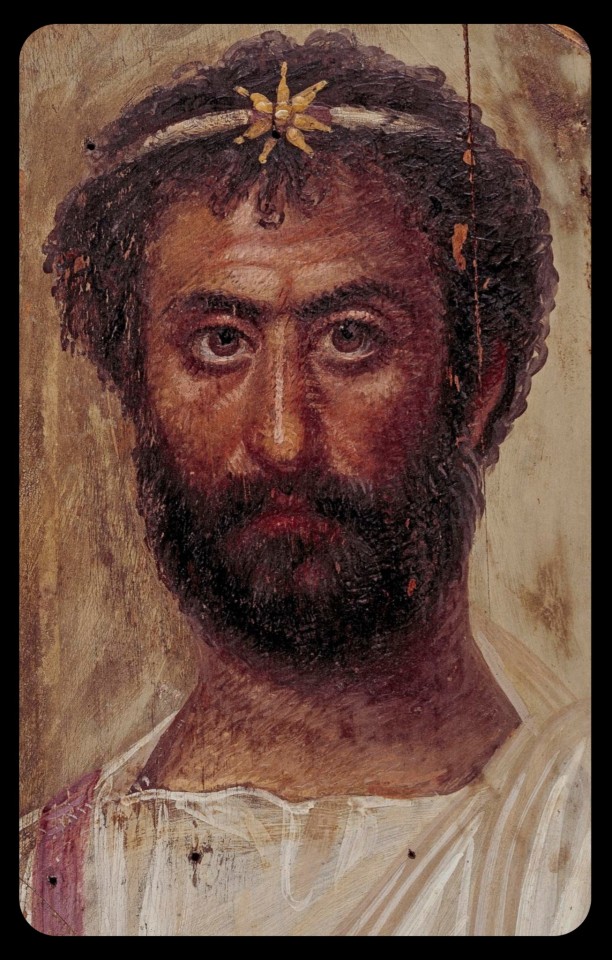
Above: portrait of a priest of Serapis, c.140-160 CE; the man in this portrait is shown wearing a fillet/crown that bears the seven-pointed star of the Greco-Egyptian god, Serapis
As this article explains:
In the 1800s and early 1900s, Western art historians didn’t know what to make of these portraits. Scholars of Roman history labeled them Egyptian. Scholars of Egyptian history labeled them Greco-Roman. These binary academic classifications failed to capture the true complexity of the ancient (or, indeed, modern) Mediterranean. In reality, Fayum portraits are a syncretic form, merging Egyptian and Greco-Roman art and funerary practices. They reflect the cosmopolitanism of both Roman and Egyptian history.

Above: portrait of a man, c.80-100 CE (left); portrait of a bearded officer, sometimes referred to as "Perseus," c.130-175 CE (right)

Above: portrait of a young woman in red, c.90-120 CE
Nearly 1,000 of these portraits are currently known to exist.

Above: portrait of a man wearing a gilded ivy wreath, c.100-150 CE

Above: portrait of a bearded man, c.150-170 CE
Sources & More Info:
Curationist: Fayum Portraits
Harvard Art Museums: Giving the Dead their Due: an Exhibition Re-Examines Funerary Portraits from Roman Egypt
Getty Museum: APPEAR Project
Getty Museum: Faces of Roman Egypt
National Geographic: Ancient Egypt's Stunning, Lifelike Mummy Portraits
The Athens Centre: The Myth of Whiteness in Classical Sculpture
Forbes: Whitewashing Ancient Statues: Whiteness, Racism and Color in the Ancient World
#archaeology#artifact#anthropology#history#ancient history#art#fayum portraits#roman egypt#ancient rome#ethnography#painting#portrait#north africa#people of color#egypt#religion#greco roman#greek#classical antiquity#fayum#mummy portraits#romano egyptian#representation
460 notes
·
View notes
Text
Poof, a powerful wizard is offering you an archive of art...
(it's magical don't worry about logistics of How but safe to assume you can enjoy everything on offer to it's fullest)
...that contains everything ever made under that medium* and auto updates when new things are created,
*for the purposes of this thought exercise things can be broken down, for instance music does include soundtracks for video games and film and written word includes scripts and meta media etc. We're playing fast and loose here because none of these so perfectly are separated from all the others and the lines blur easily. This is a question about preferences not classification which better students than I have tried to define. Play with me in this space.
**including digital
#i realize like film and stage are wildly different#but the wizard is a simple man and no one said you had to look at everything in the archive#its just being made available to you#same goes for the visual arts but asdklfj#again its not a perfect thought experiment
2K notes
·
View notes
Text







Reliquary Bust of Saint Balbina
Date: ca. 1520–30 Geography: Made in possibly Brussels, Belgium Culture: South Netherlandish Medium: Oak, with paint and gilding, and human remains Dimensions: Overall: 17 1/2 x 16 x 6 1/4 in. (44.5 x 40.6 x 15.9 cm) Classification: Sculpture-Wood
185 notes
·
View notes
Text
Let's take a look at the ninth art...
Given Asterix and Obelix has been getting popular again, I thought I'd do something I wanted to quickly write down for a long time - some posts to introduce those unfamiliar with to the world of... BD!
"BD"? Bande-dessinée. The French word we use for what Americans call "comic books" or "comics" or "graphic novels". Technically speaking, BD can cover the entirety of European comics production, but traditionally people refer to the "Franco-Belgian BD", "la BD franco-belge", as the heart of the European production was formed out of the industrial duo of France and Belgium.
Now, why would you or I use this obscure non-English term "BD" or "bande-dessinée"? Why not just say "European comics" or "French comic book"? Well... Why do you use "manga" and not "Japanese comic"? That's the same thing. Bande-dessinée works a lot like the American comics yes, and in fact, when I took a class at university about the history of BD, the teacher kept referring the theories of Will Eisner and Scott McCloud - BD, like comic books, are two manifestations of the "sequential art" as a whole... However, BD has a very different publishing process, a different historical evolution, a different social reception and cultural context than comics, and so it earns the right to have a specific denomination to separate it from American comics, the same way Japanese mangas are called "mangas". In fact, manga, comics and BD form the holy trinity of the sequential art, the three main manifestations of this specific medium - on one side Batman, Calvin and Hobbes, the Marvel comics ; on the other One Piece or Akira, and in the middle Tintin and Asterix and others...
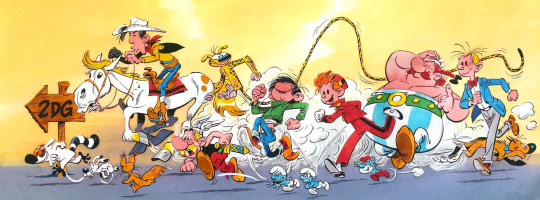
BD received various other names, from the derogatory to the glorifying.
A derogatory name? "Petits mickeys" (small mickeys), alternatively spelled "petits miquets" (small miquets, a francization of the term apparently from Pascal Oury). This term, from the 60s and 70s, was used to refer to BDs under the angle of low-quality, of "popular", "low" works. "To draw little mickeys, to read little mickeys, to make little mickeys". The term was also used, in a lovingly ironic way, out of self-mockery, by various BD creators such as Goscinny or Gotlib (today you can hear people say this term is tied to the Pilote and Fluide Glacial generations, 60s-80s). Some wonder if it isn't Sempé who made the term "mainstream", through humoristic drawings he made showing how people asked him if he was the one draing "little mickeys". Of course, this is an obvious reference to Mickey, the character from Disney, but it isn't just some sort of "Americanization" thing... The reason Mickey became associated with BD was due to "Le Journal de Mickey" (a famous French comic-magazine), which has been in France one of the historical outlets for introducing and developing the BD in France. But as a result, it led to the perception of BDs as simple stories, as childish things aimed at a young audience, and at "Mickey-adjacent" (and thus Disney-adjacent) products.

A glorifying term? Le neuvième art, "the ninth art". This famous and common denomination (which ranks the BD production to the rank of "art") is based, not on the "seven arts" of the Middle-Ages, but rather on a different system of art classification... You see, in the 19th century, a certain "art hierarchy" was popularized (by Hegel). It deemed that there were five main arts, which in rank of importance were architecture, sculpture, painting, music and poetry. However, after Hegel's classification became popular many authors and thinkers started to add their own arts - in the 1920s, Ricciotti Canudo notably added the "sixth art" (dance) and the "seventh art" (cinema). Though not everybody agreed on what was what - for example, while today the sixth art is "dance", for quite some times it was "photography". And while Canudo added the sixth and seventh art, he had his own concept of the five arts - for him it was poetry, music, theater, plastic arts and eloquence/rhetoric.
Anyway, BD soon became the "ninth art". Morris (creator of the "Lucky Luke" series) and Pierre Vankeer wanted to officially call BD the "eighth art", but they discovered the term was already taken - Roger Clausse used it for radio in the 1940s, but it quickly became a common term for television as a whole and englobed within itself photography... So, Morris-Vankeer chose the "ninth" art for BD and, in a strange coincidence, on the very SAME year Morris-Vankeer published their denomination of "ninth art" (1964), Claude Beylie published his own article deemed BD the "ninth art". (And also, little historical trivia, the term existed by the 1920s but it was to designate gastronomy, and it never took off).
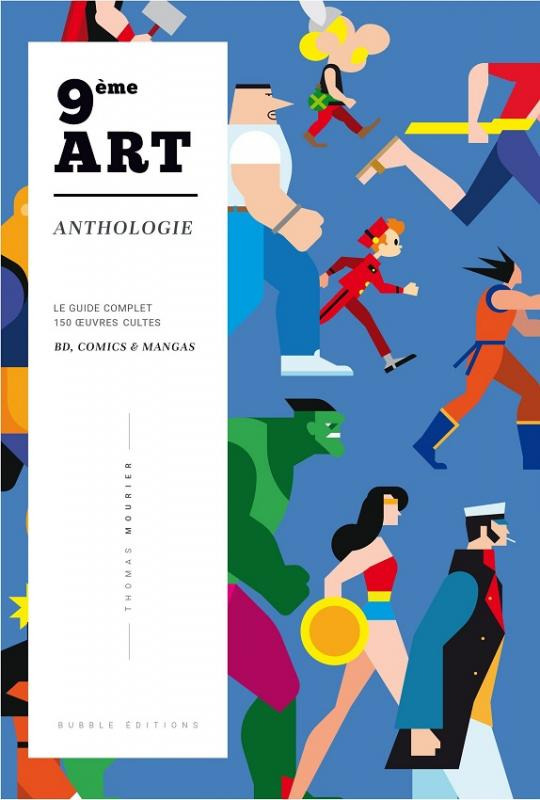
There is also quite a big debate over whether BD should be considered literature or not. It is primarily a narrative with prominent illustrations? Or is it primarily a visual art with some narrative stuck to it? What is more important, the drawing or the text? Is it closer to books or to paintings? Do we focus on the visual logic and the aesthetic, or the storytelling devices? It doesn't help that BDs come in a wide variety, from products very thick and heavy with text, to BDs without any text. From Boulet to Edgar P. Jacobs, from Les Cités Obscures to Blake et Mortimer...
Without going back to the Egyptians and their hieroglyphs, the class I took about the history of BD did point out how the roots of the "sequential art" in France could go back as far as the stained glass of churches, and the very famous Bayeux tapestry.
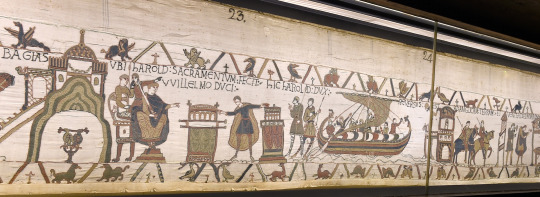

But the story of BD really begins with Rodolphe Töpffer, the man who is thought as the inventor of BD as a whole. You might know of him if you looked into the history of comics books because he is also thought of as the grandfather of American comics. What he wanted to create, first and foremost, was what he called "littérature en estampes" (literature in prints, literature by engravings). He was coming from the world of traditional books and novel-publishing, and thus had a very literary approach to it all. He wanted a form of literature where text and image would co-exist as equals, united for satirical and humoristic purposes. Because that was one of the main features of his work - to have caricatural characters, with exaggerated features, placed within comical situations.
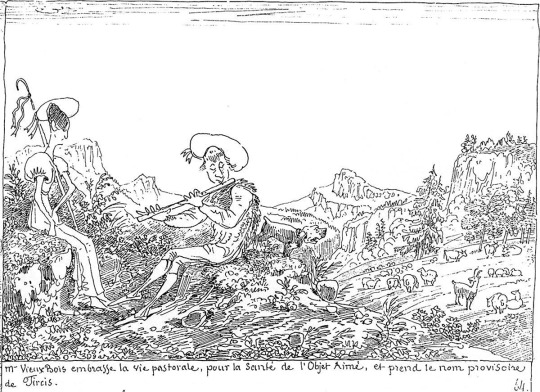


With Töpffer, we find a true "balance of the sequential art". Because the images are clearly dependant and "submissive" to the text, in terms of narration and storytelling, but in return the visual has a much larger part on the page and is what catches the eye immediately. As a result, we have a proto-comic which relies heavily on the text, but where the drawing is what makes it interesting in the first place - and the visuals are needed to appreciate what the text is saying - and these texts usually explore the logic of mismatching, discordance, and absurdity.
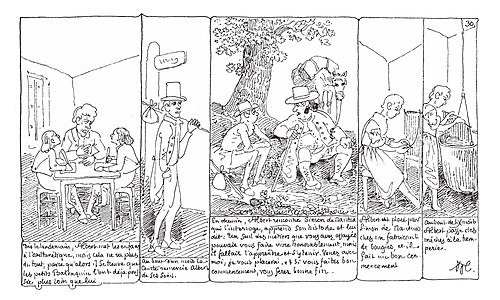

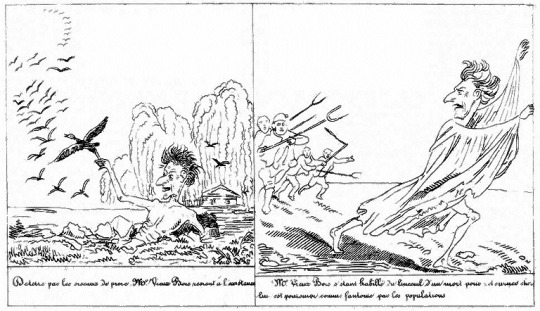
Töpffer's work spread throughout Europe, and even reached the USA... And yet never gained any fame. It was not a huge success, it was never a best-seller, in fact it sold in small quantities and limited editions. And yet, it still had a big influence over the various illustrators and cartoonists of the time, and gained a small celebrity in the world of caricatures. But for Töpffer to REALLY become famous and a public figure, we would have to wait for when people started studying the history of BDs and comics...
And what Töpffer changed, through his work, was the idea of these doodles and cartoons existing on their own. Given the development of comics always deeply relied on the developments of the printing industry, they rarely could exist "alone" - unlike text, printing comics required more machines, more supplies, more technique, more effort, and so they usually appeared as caricatures within daily or weekly newspapers, or as comic strips to illustrate a text, they appeared within places of recurring, regular publications that were however not their "own". The BD industry grew out of this logic of recurring, repetitive publications, and still kept a format of "serial". But Töpffer published his little comics on their own, within their own books, without anything else but them - they were sold for themselves. And that's how it changed things.
The BD also primarily began as a form of... "degraded literature", so to speak. It was seen as a storytelling form perfect for almost-analphabetical people and for people with reading difficulties - first of all being children. The BD fed from this concept developed in the 19th century of "youth-literature for young readers", this idea that children could have and deserved their own books separate from the readings of their parents (Jules Vernes notably played a big role in creating this "literature for children" in France). This, tied to how crude, fast-made and easy-to-reproduce the BD drawings were at the time, resulted in a general perception of BD as a form of "futility". BD was there for humoristic satires, funny caricatures, children publications. It can be compared to how the "mangas" were originally drawings of a "low", "mundane" daily-life, opposed to the "high" and "real" art of drawing landscapes.
And this initial "futility" explains a LOT about the history of BD and how it evolved. The first step of the BD history was to prove its "interest" and its "utility", by becoming a "useful" thing, by turning into a tool of pedagogy or a "good" form of entertainment. And once the BD became a legitimate, mainstream, mass-produced "classic" thing, then came a second era of counter-culture, where BD became more experimental and more mature, reaching out for an adult audience.
The "periodical" publication of BDs by "chapters" or "issues" was not truly preserved. Unlike American comics and Japanese manga, where the serial chapter-publication or the periodic-issues release is still a foundation of the industry, the BD industry ditched it all and relies rather on the publication of full "volumes" or complete "collections", as a full book with a solid cover. Before it is true that the income of BD creators came from the "perodics", with their work only being bound in a single volume, a "hardcover", as a "bonus" or a "reward" that confirmed the success of the series - but today BD relies almost exclusively on the publication of full volumes.
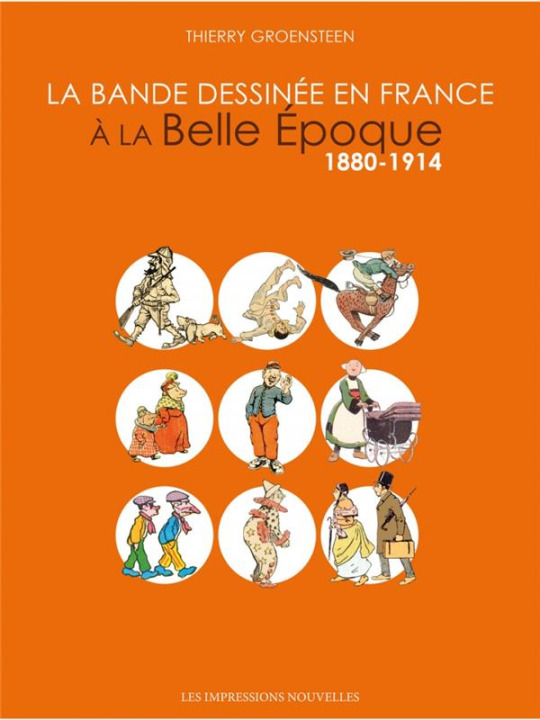
After Töpffer, the "littérature dessinée" (drawn literature) affirmed itself more and more, through satirical caricatures and humoristic tales. It never became the main production of artists - they were primarily illustrators or photographs, and they only did proto-BD as an aside. You had Cham, who took a lot after Töpffer, you had Nadar, who caricatured the mid-19th century politics, you have Gustave Doré too, yes THE Gustave Doré...

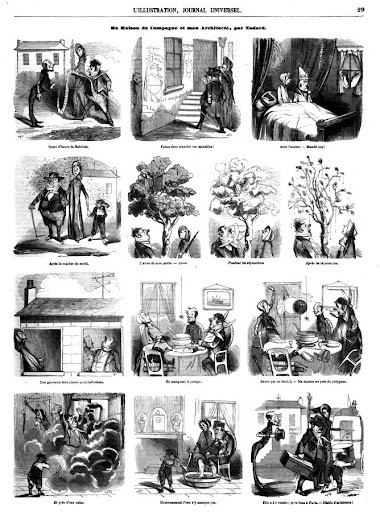
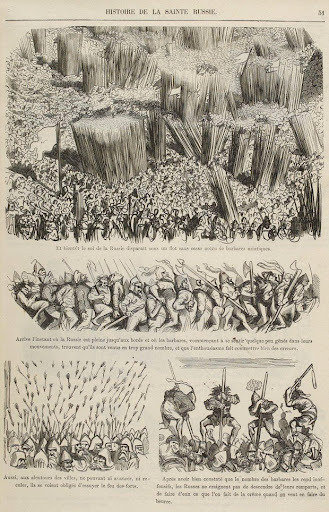
But the next big turn, the one that changed the "generic humoristic stories" into a "specific illustrated literature for children" was "La Famille Fenouillard" by Christophe, considered one of the first real BD of France (1889-1893). And again, we find here a specific balance between text and image. You have a LOT of text, that is a big dependance on the text - it is there that all the story takes place... But the drawings meanwhile are very attracting, very insisting, because they are incomplete scenes and visual enigmas that encourage the reader to check what they are about. The image attracts the gaze, creates the curiosity, the wonder, creates the question, whereas the text offers the answer. We are still in quite simple, not complex stories, but they play a lot on dichotomy - for example the drawings offering joyfull, happy, positive situations, that get more shady, more dubious if not dangerous once you add the text to them.


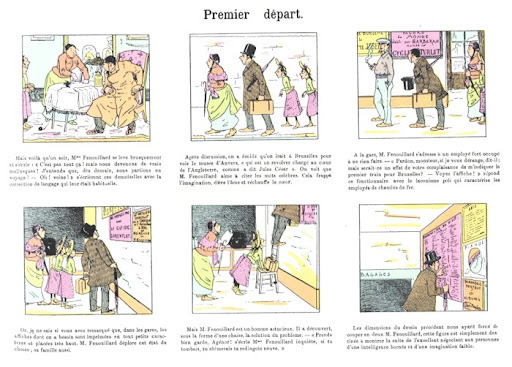

While I speak a lot of France, Germany has its own things going on aside - most notably, it developed what would become a very common genre in European BD, the "petits garnements" genre. Stories of brats, mischievious boys and little devils - such as the classic "Max und Moritz" (1865). This resulted in a wide fashion of duos or trios of prankster-heroes, that would create a lasting associated in culture between "childhood, youth" and "transgression, disobedience, trick". But here, we are closer to an illustrated tale rather than a "true" comic.


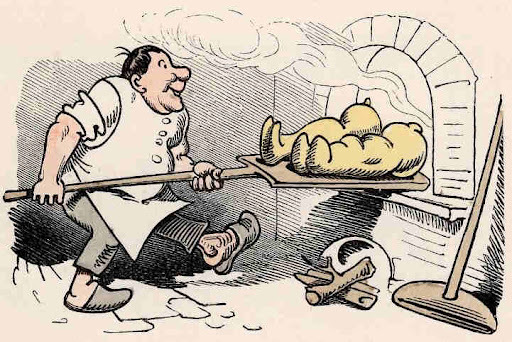
For more about the history of BD, see you in the next post...
#let's explore the ninth art#ninth art#bd#bande-dessinée#bande dessinée#comic books#comics#history of comics#history of BD#french history#france#french comics
21 notes
·
View notes
Text


In 1925 the Kunsthalle in Mannheim opened an exhibition that coined a term that to this day represents one of Germany’s most important interwar art movements: „Neue Sachlichkeit“, curated by Gustav Hartlaub, showed a genre-crossing selection of works connected by realism, social commentary and the detailed depiction of contemporary life. It thus represented an antithesis to the emotion-driven subjectivity of expressionism and offered an analytical view on the constitution of Germany after WWI.
In honor of the Mannheim exhibition’s centenary the Neue Galerie in New York up until May 26 shows „Neue Sachlichkeit/New Objectivity“, a comprehensive presentation of well and lesser-known works associated with the movement. Alongside the exhibition Prestel published the eponymous catalogue, edited by curator Olaf Peters, that brings together a variety of works from the exhibition and insightful essays providing context to the Neue Sachlichkeit movement. In his introductory essay Olaf Peters provides a comprehensive overview of the Neue Sachlichkeit’s intellectual and social environment, its key exponents and the strands characterizing it. The latter are the leftist, sociocritical Verists like Otto Dix, George Grosz and Rudolf Schlichter and the more conservative, sometimes right-wing Classicists. But Peters rightly notes that these classifications aren’t cast in stone and have already in 1925 been expanded to Magic Realism and painters like Franz Radziwill by Franz Roh. Following Peters’ essay, Birgit Dalbajewa and Carina Plath provide exemplary studies on the important centers Dresden and Hannover with the first centering around Otto Dix and the former addressing the emancipated female painters in the Weimar Republic. In accordance with the broadness of the movement catalogue and exhibition also take into account the sculpture, film and photography of Neue Sachlichkeit as well as interior architecture exemplified by the Bauhaus and the Neue Frankfurt.
Against the backdrop of the profound essays and excellent illustrations included in the catalogue it is a highly recommended read that makes accessible the current state of research into Neue Sachlichkeit to an English-language audience while also providing a broad overview of this pivotal artistic movement in Weimar Germany. Superb!
#neue sachlichkeit#new objectivity#modern art#art book#prestel#exhibition catalogue#art history#book
22 notes
·
View notes
Photo

Male Harp Player of the Early Spedos Type, 2700–2300 B.C.
Artist/Maker: Unknown Culture: Cycladic Place: Cyclades, Greece (Place Created) Date: 2700–2300 B.C. Medium: Marble Dimensions: 35.8 × 9.5 × 28.1 cm (14 1/8 × 3 3/4 × 11 1/16 in.)
Department: Antiquities
Classification: Sculpture
The J. Paul Getty Museum, Villa Collection, Malibu, California
Illustrations of musical performances are scarce in Cycladic art, and this harpist is one of the few known examples. Sitting erect on a simple four-legged stool with his face lifted in song, he plays a frame harp—a stringed instrument that originated in the Near East—while resting his right hand on its sound box.
The extension at the top, a common feature on ancient stringed instruments, facilitated the projection of the sound. Originally the figure’s eyes and hair were added in paint. This challenging composition of a seated player, stool, and delicate frame was shaped from a block of solid marble and then patiently ground down with pumice and emery, locally available abrasives. The resulting three-dimensional design is a masterpiece of Bronze Age sculpture.
#ancient art#cycladic#harp#ancient greek art#musicians#sculpture#art#mu art#mu#mu ancient#20 art#20 notes
40 notes
·
View notes
Text









5-6世纪·阿富汗 佛首
Title: Head of Buddha
Date: 5th–6th century
Culture: Afghanistan (probably Hadda)
Medium: Stucco with traces of paint
Dimensions: H. 7 1/2 in. (19.1 cm); W. 4 3/4 in. (12.1 cm); D. 4 1/2 in. (11.4 cm)
Classification: Sculpture
Credit Line: Rogers Fund, 1930
Accession Number: 30.32.5
The well-preserved surface and traces of paint provide an idea of what this head looked like when it was being used in worship. The abstracted treatment of the eyes and the intersecting plains defining forehead, eyebrows, and nose are stylistic features shared with imagery produced in north India during the Gupta period. The fact that this north Indian way of presenting the Buddha had penetrated into Afghanistan suggests a shared Buddhist tradition.
Photos via friend 陳浩
小紅書: 11600879720
youtube
🎧 🫶 Enjoy Music by Prem Joshua - Sky Kisses Earth Full Album 1999/德國音樂家Prem Joshua (b. 1958 German),自 1969 年以來一直活躍在音樂界。 他五歲開始學習長笛,12 歲時在當地多個樂隊演奏長笛和薩克斯風。 18 歲他前往印度,沿途研究各個國家的土著民間音樂。
Tracklist
Sky Kisses Earth 0:00
Remember This! 13:29 (altered audio from original)
Dakini 19:03
Night Rain 32:02
The Seventh Eclipse 39:27
Earth Kisses Sky 46:56
#buddha#afghanistan#5th–6th century#小紅書: 11600879720#sculpture#prem joshua#b. 1958 german#sky kisses earth 1999#calssical music#new age#indian classical hindustani#indian classical music#hindustani classical
18 notes
·
View notes
Text
TMAGP 33 - Peer Review
Reactions and theories
Spoilers Below!
Reactions:
Dyhard arguging??
Chester??? The Magnus Institute??? CELIA WHAT ARE YOU DOING???
Private and confidential??? Apparently not.
A statment??
Dr. Welling...wasn't he involved in another statement?
Victoria Marcario
Can I get you tea?? Gerturde???
James Dawn
Who is the interviewer and what comments are they asking????
Arcade... maybe something to do with the Stranger?
Fog?? THE LONLEY???
Caricature artist?? Similar to the sculpture in TMA??
Aww they sound cute
The Lonely + the Spiral maybe?
They BOTH got trapped in the Lonley?? Maybe it works more like the Distortion's door?
Babes, you're not paranoid, you're expereincing the horrors.
Oh dear, you are sooo lonley coded.
Different door, same man - MICHAEL????????? MY BOY?????
James you don't have to worry about worsening the mood, the horrors are here
Nooo they got James didn't they??
Is he fighting the Spiral??? Trying to make it seem 'normal?'
Aww, sounds like denial....
This reminds me of the first Lukas case we got in TMA.
He was screaming? Oh no...
So it was after James then...
That's what the Institute is here for!
"Please don't go," Oh no....
Colin's notebook???
He wrote in computer codes and German??
Codes, like alchemy????
Alice is going down the rabbit hole, isn't she?
5399752
Lena??? Is she ok?????
She's off the grid, it seems. Hopefully, she's ok and having a great vacation!!
Gwen when someone says she's incharged: O o O
Bret Larse from STARKWELL????
Augustus sent that email didn't he??
Off-site security??
He KNOWS ABOUT THE EXTERNALS??? LENA SHIFTED FROM STARKWELL TO THE EXTERNALS??? HOW BAD ARE THEY????
Tell him off Gwen!!
Things can get hairy??? Never left a job unfinished??? Oh no...
Yes Gwen, decline his offer!!
He's going to make something happen, isn't he?
Yes GWEN TELL HIM OFF!!
Theories:
Dr. Welling WAS in another statement (TMAGP21), he was the one to submit the calculations for the "only good" dome/world/utopia.
The interviewer was definitely marked by the Eye, judging how the statement is like those in TMA, but they seem to have to ask more questions to get the answers they want. I wonder if this was Gertrude since, from what we heard in TMA, that seems to match her style of live/recorded statements.
The statement itself seems to have a culmination of Spiral and Lonley elements. Perhaps it is a new fear classification, like the 'Deep' the dead woman described in TMAGP 15 - Well Run.
For Colin's notebook, he was clearly paranoid, and I think the codes he wrote in was Alchemy. Celia seems to be playing dumb and not really willing to help, which supports my theory that she pushed Sam and needs him to stay for "balance" sake. This was her only goal and while she does like Alice and Gwen, she doesn't care about them to enough to get involved in the Horrors.
For Gwen's meeting, I think Augustus sent that email to Starkwell. It would make sense: no more externals/chaos, but they get someone on the inside to corrupt Gwen. Judging Lena's prioritization of safety and her very clear actions to NOT get employees involved with Externals, Starkwell has to be corrupted in some way, possibly working for the Institute (or what's left of it, anyway) or her bosses. They are dangerous, and I really hope Gwen won't get involved with them.
I really hope Lena is ok now that she is seemingly off the grid. I think she is going to get the Gertude treatment for a little while at least, where all the strange/disorganized things she did (at least, that's how Gwen views it) will be reveales to have been extremely helpful once Gwen undos them. This is not to say Gwen is going to be Jon and Lena will be Gertude, but I think that their roles will be similar for a little while. I'm really hoping Lena comes back to knock some sense into the OIAR crew and help them stop whatever is going on.
No bingo card update because it's still the same lol.
#tmagp#the magnus protocol#tmagp spoilers#the magnus protocol spoilers#ghost and tmagp#celia ripley#alice dyer#gwen bouchard#gwendolyn bouchard#lena kelly#colin becher#tmagp 33#tmagp reaction#tmagp theory#theories#reactions#magpod
14 notes
·
View notes
Text
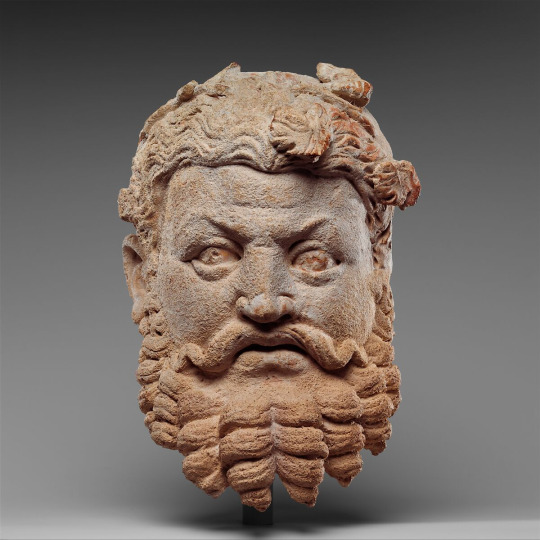
Title: Head of Dionysos (The God of Wine and Divine Intoxication)
Date: 4th–5th century
Culture: Pakistan (ancient region of Gandhara)
Medium: Terracotta
Dimensions: H. 10 1/4 in. (26 cm); W. 7 in. (17.8 cm); D. 6 3/4 in. (17.1 cm)
Classification: Sculpture
Credit Line: Gift of Mr. and Mrs. Uzi Zucker, 1979 Vía https://www.metmuseum.org/art/collection/search/38226
57 notes
·
View notes
Text
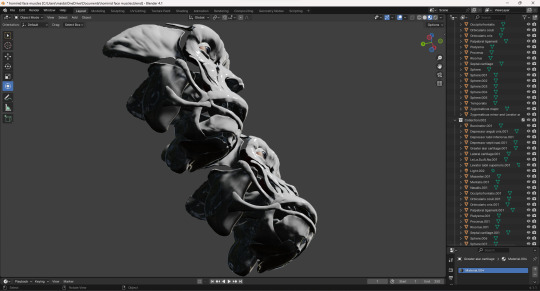


Here's some hominid soft facial anatomy : )
The model on the right of frame, representing Australopithecus sediba, has been in sporadic progress for over a year now across a few programs, and I was able to create the model on the left of frame by conforming all the A. sediba elements to the Kabwe cranium (belonging to Homo heidelbergensis *or* H. bodoensis by some classifications). That latter process took place entirely in Blender over only a couple days, so I'm pretty happy with this method. While the skulls themselves aren't visible in these screenshots, they are part of the Blender file and were downloaded directly from MorphoSource, which was pretty helpful. Digital sculpture (SculptFab, SculptGL, 3D Builder, Blender), 2023-24
#Australopithecus sediba#Kabwe cranium#Homo heidelbergensis#Homo bodoensis#Blender#hominid reconstruction#facial anatomy#anatomical model#digital sculpture#3d rendering#musculature#tendons#cartilage#eyeballs#human evolution#comparative anatomy#Christopher Maida Artwork
15 notes
·
View notes
Text
I had a dream just exploring the most amazing library and museum. the books in the teen area were shelved by color and their classification system somehow corrected for the wayfinding issues that would cause. there were sculptures and exhibits everywhere, I was in there for hours and never went in the same room twice
4 notes
·
View notes
Note
Pepper, according to Wikipedia..:
"Origami (折り紙, Japanese pronunciation: [oɾiɡami] or [oɾiꜜɡami], from ori meaning "folding", and kami meaning "paper" (kami changes to gami due to rendaku)) is the Japanese art of paper folding. In modern usage, the word "origami" is often used as an inclusive term for all folding practices, regardless of their culture of origin. The goal is to transform a flat square sheet of paper into a finished sculpture through folding and sculpting techniques. Modern origami practitioners generally discourage the use of cuts, glue, or markings on the paper. Origami folders often use the Japanese word kirigami to refer to designs which use cuts.
In the detailed Japanese classification, origami is divided into stylized ceremonial origami (儀礼折り紙, girei origami) and recreational origami (遊戯折り紙, yūgi origami), and only recreational origami is generally recognized as origami.[1][2] In Japan, ceremonial origami is generally called "origata" (ja:折形) to distinguish it from recreational origami. The term "origata" is one of the old terms for origami.
The small number of basic origami folds can be combined in a variety of ways to make intricate designs. The best-known origami model is the Japanese paper crane. In general, these designs begin with a square sheet of paper whose sides may be of different colors, prints, or patterns. Traditional Japanese origami, which has been practiced since the Edo period (1603–1868), has often been less strict about these conventions, sometimes cutting the paper or using nonsquare shapes to start with. The principles of origami are also used in stents, packaging, and other engineering applications."
I uh, hope this helps. I know how to make the origami cranes and stars soo I can teach you some too.
(she's kinda a moron I like her)
🛼- "That's a lot of words! You're very smart for a bird!".
2 notes
·
View notes
Text
Introduction Mary Ellen Solt
From Concrete Poetry: A World View (1968, Indiana University Press)
The term "concrete poetry" is now being used to refer to a variety of innovations and experiments following World War II which are revolutionizing the art of the poem on a global scale and enlarging its possibilities for expression and communication. There are now so many kinds of experimental poetry being labeled "concrete" that it is difficult to say what the word means. In an article in THE LUGANO REVIEW (1966), the English critic Mike Weaver, who organized The First International Exhibition of Concrete and Kinetic Poetry in Cambridge in 1964, distinguishes three types of concrete poetry: visual (or optic), phonetic (or sound) and kinetic (moving in a visual succession). And he sees individual poems within these three classifications as related to either the constructivist or the expressionist tradition in art. The constructivist poem results from an arrangement of materials according to a scheme or system set up by the poet which must be adhered to on its own terms (permutational poems). In the expressionist poem the poet arranges his material according to an intuitive structure. Weaver's definitions and classifications are most clarifying when applied generally; but when we are confronted with the particular text or poem, we often find that it is both visual and phonetic, or that it is expressionistic as well as constructivist. It is easier to classify the kinetic poem because it incorporates movement, usually a succession of pages; but it is essentially a visual poem, and its words are, of course, made up of sounds. We need only to look at Emmett Williams kinetic book SWEETHEARTS to see that it is possible to incorporate everything we have said about concrete poetry in this paragraph in one poem. Often concrete poems can only be classified in terms of their predominating characteristics.
The situation is such that the poets themselves are often reluctant to make the unqualified statement: "I am a concrete poet." In most cases they will say: "It depends upon what you mean by 'concrete'." The poets presented in this selection will for the most part accept the label "concrete" in its broad definition, very few in its narrow. Usually they prefer to find another name for their particular experiments. Often they speak simply of visual or sound poetry.
Despite the confusion in terminology, though, there is a fundamental requirement which the various kinds of concrete poetry meet: concentration upon the physical material from which the poem or text is made. Emotions and ideas are not the physical materials of poetry. If the artist were not a poet he might be moved by the same emotions and ideas to make a painting (if he were a painter), a piece of sculpture (if he were a sculptor), a musical composition (if he were a composer). Generally speaking the material of the concrete poem is language: words reduced to their elements of letters (to see) syllables (to hear). Some concrete poets stay with whole words. Others find fragments of letters or individual speech sounds more suited to their needs. The essential is reduced language. The degree of reduction varies from poet to poet, from poem to poem. In some cases non-linguistic material is used in place of language, in the plastic poems of Kitasono Katue, for instance, or in the "Popcreto" of Augusto de Campos, which is a Tower of Babel of eyes. But the non-linguistic objects presented function in a manner related to the semantic character of words. In addition to his preoccupation with the reduction of language, the concrete poet is concerned with establishing his linguistic materials in a new relationship to space (the page or its equivalent) and/or to time (abandoning the old linear measure). Put another way this means the concrete poet is concerned with making an object to be perceived rather than read. The visual poem is intended to be seen like a painting; the sound poem is composed to be listened to like music. Concrete poets, then, are united in their efforts to make objects or compositions of sounds from particular materials. They are disunited on the question of semantics: some insisting upon the necessity for poetry to remain within the communication area of semantics, others convinced that poetry is capable of transmitting new and other kinds of information--purely esthetic information.
But no matter where the concrete poet stands with respect to semantics, he invariably came to concrete poetry holding the conviction that the old grammatical-syntactical structures are no longer adequate to advanced processes of thought and communication in our time. In other words the concrete poet seeks to relieve the poem of its centuries-old burden of ideas, symbolic reference, allusion and repetitious emotional content; of its servitude to disciplines outside itself as an object in its own right for its own sake. This, of course, asks a great deal of what used to be called the reader. He must now perceive the poem as an object and participate in the poet's act of creating it, for the concrete poem communicates first and foremost its structure.
0 notes
Photo

Large Fossil Gastropod (Galeodea sp), Oligocene, Blakely Formation, Twin Rivers WA USA | Authentic Specimen + COA
Large Fossil Gastropod (Galeodea sp) – Blakely Formation, Oligocene Epoch, Twin Rivers, Washington, USA
This impressive and well-preserved specimen is a fossil of Galeodea sp., a genus of large marine gastropods. It was collected from the Blakely Formation near Twin Rivers, Washington, and dates to the Oligocene Epoch—approximately 30 to 25 million years ago. Fossils like this represent ancient sea life that inhabited the coastal marine environments of the Pacific Northwest during the Paleogene.
Fossil Type & Classification:
Type: Invertebrate Fossil (Marine Gastropod Shell)
Genus: Galeodea sp.
Phylum: Mollusca
Class: Gastropoda
Order: Neogastropoda
Superfamily: Tonnoidea
Family: Cassidae (Helmet and Bonnet snails)
Identified by: Commonly referenced in regional molluscan faunal lists from the Blakely Formation
Geological & Stratigraphic Details:
Location: Twin Rivers, Washington, USA
Formation: Blakely Formation
Geological Stage: Oligocene, Paleogene Period
Age Range: ~30–25 million years ago
Depositional Environment: Shallow marine coastal shelf and embayment with sandy to muddy sediments supporting diverse molluscan fauna
Morphology & Features:
Thick, spirally coiled shell with expanded body whorl and well-defined spire
Surface ornamentation may include spiral ridges and growth lines
Aperture large and rounded, consistent with Cassid gastropods
Preserved in natural matrix or as isolated shell fossil, sometimes with internal infilling
Large size and robustness make it a visually striking display specimen
Notable: Members of the genus Galeodea are predatory sea snails and part of the Cassidae family, known for their thick shells and often elaborate surface sculpture. Fossils from the Blakely Formation provide critical insights into Oligocene marine ecosystems along the ancient North American West Coast. Specimens of Galeodea are valued by collectors for their rarity and substantial size.
Specimen Details:
Origin: Twin Rivers, Washington, USA
Species: Galeodea sp.
Fossil Type: Marine Gastropod Shell
Geological Epoch: Oligocene
Formation: Blakely Formation
Size Reference: Scale cube = 1cm (refer to photo for exact sizing)
Note: The exact specimen shown in the listing photo is the one you will receive
Authenticity & Quality: This is a 100% genuine fossil, naturally preserved and professionally curated. Comes with a Certificate of Authenticity. No enhancements or reconstructions.
Why Choose This Fossil? Ideal for:
Marine mollusk fossil collectors
Educational use in palaeontology and invertebrate studies
Museum-quality display pieces
Natural history collectors seeking large gastropod specimens
Shipping & Packaging: We ship worldwide using eco-conscious packaging and tracked delivery. Each fossil is securely wrapped and boxed for safe arrival.
Add a bold and authentic example of Cenozoic marine life to your collection with this large Galeodea gastropod fossil from Washington’s Oligocene Blakely Formation.
All of our Fossils are 100% Genuine Specimens & come with a Certificate of Authenticity.
#Galeodea fossil gastropod#Oligocene marine snail fossil#Blakely Formation fossil shell#fossil gastropod Twin Rivers WA#large fossil sea snail#fossil mollusk shell Washington#authentic fossil with COA#collector gastropod fossil#Cenozoic fossil snail USA#Galeodea fossil specimen#marine invertebrate fossil#paleontology gastropod
0 notes
Text
𝐼𝑛𝑡𝑟𝑜𝑑𝑢𝑐𝑖𝑛𝑔: 𝑨𝒏𝒂𝒕𝒐𝒎𝒊𝒄𝒂 𝑶𝒃𝒔𝒄𝒖𝒓𝒂

Sculptor. Muse. Enigma. Alise Marcheline has built a career crafting beauty from the grotesque - bronze castings so intimate they feel embalmed, not imagined. When Dr. Hannibal Lecter begins leaving offerings at her door — surgical, poetic, precise — it is not a message. It is a communion. What begins as fascination becomes ritual. Bone becomes relic. Desire becomes religion. And as the lines blur between artist and devotee, one truth remains: There is no god in this cathedral-only the woman he kneels for.

𝑫𝒓. 𝑯𝒂𝒏𝒏𝒊𝒃𝒂𝒍 𝑳𝒆𝒄𝒕𝒆𝒓
Classification: High-Risk Asset Occupation: Forensic Psychiatrist ┆ Culinary Expert ┆ Art Collector Known Alias(es): None active. "The Chesapeake Ripper" — formally dismissed.
Summary: Lecter maintains elite social ties through cultural and philanthropic circles. Highly intelligent, fluent in multiple languages, skilled surgeon. Possesses encyclopedic knowledge of classical music, Renaissance art, and postmodern cuisine. Currently showing unusual interest in Alise Marcheline. Frequents Oriel & Thorn gallery.

𝑨𝒍𝒊𝒔𝒆 𝑴𝒂𝒓𝒄𝒉𝒆𝒍𝒊𝒏𝒆
Classification: ░R░░E░░D░░A░░C░░T░░E░░D░ Occupation: Sculptor — Specializing in macabre installation art Known Alias(es): None confirmed. "The Bone Maiden" — unverified.
Summary: Subject resides in a converted industrial foundry. Sleeps surrounded by her own work — her studio is a repurposed warehouse that acts as both her studio and her apartment. Keeps irregular hours, most active between midnight and dawn. Sculptures suggest anatomical precision beyond formal education. Psychological profile incomplete — clinical interviews consistently refused. Suspected history of trauma. Close with Camille Desrosiers.

𝑪𝒂𝒎𝒊𝒍𝒍𝒆 𝑫𝒆𝒔𝒓𝒐𝒔𝒊𝒆𝒓𝒔
Classification: Civilian Occupation: Columnist (Pop Culture, Society & Arts) ┆ Freelance Contributor Known Alias(es): Cam — personal only
Summary: Long-term friend of Alise Marcheline. Attended Bryn Mawr College together. No criminal history. Personality disarms most formal inquiry. Despite perceived frivolity, demonstrates high emotional intelligence and loyalty.
Unaware of Marcheline's deeper activities — suspected to be under passive manipulation. Monitoring advised. Risk of collateral discovery increasing.
⊹˚₊‧ ︵ ˖ ‿ ༺ ༻ ‿ ˖ ︵ ‧₊˚⊹
Disclaimer 🪦ྀིྀིྀིྀིྀི ∿ᝰ.ᐟ
All characters, lore, and settings associated with Hannibal belong to Thomas Harris and the creators of the television adaptation. This work is a transformative, fan-created exploration and is not affiliated with or endorsed by any official entities. No copyright infringement is intended. The original characters of Alise Marcheline and Camille Desrosiers, along with their respective backstories, narrative arcs, and any additional worldbuilding are entirely my own. Please don't repost or adapt without permission.
Trigger Warnings 🪦ྀིྀིྀིྀིྀི ∿ᝰ.ᐟ
Graphic depictions of violence and gore (including murder, blood, and cannibalism) Serial killer themes (psychological manipulation, stalking, ritualistic violence) Sexual content (explicit scenes, BDSM-adjacent elements, power dynamics) Psychological horror (obsession, delusion, unreliable perception) Body horror and anatomical references (artistic use of body parts) Death and trauma (emotional and physical, both referenced and depicted) Mild drug references (prescription medication, potential dissociation) Mentions of childhood trauma Power imbalances and emotional manipulation Religious and blasphemous imagery (especially related to worship, sacrifice, and art-as-ritual) Unreliable narration and time dissonance (which may impact emotional realism and perception of events)
This is a dark romance and psychological horror narrative. It explores morally grey characters in intimate, sometimes disturbing scenarios.
Please read with care. A Note on Time (Recommended Read) Chapter List
Eventually Will Graham will be featured as a large part, but that is not until the later chapters — sorry. ˙◠˙
୧ ‧₊˚ 🕯️⛓️ 📜 ⋅‧₊
#hannibal#hannibal nbc#nbc hannibal#hannibal fic#hannibal x oc#dark romance#fanfic#fanfiction#red dragon#𓂃 ࣪˖ ‧₊˚ 𝐮𝐧𝐢𝐯𝐞𝐫𝐬𝐞 ⋅. ⠀ ⠀ ⠀ ⦙ ⠀ ˙‧₊˚ ₊˙‧₊ ❪ anatomica obscura ❫
0 notes